Mud and muck around Millersylvania State Park
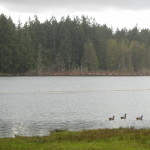 Almost every year I pack up the family and head ten miles south of our Lacey home to go camping at Millersylvania State Park, and every time we make plans to take advantage of the miles of woodland trails skirting its edges. Unfortunately, for a multitude of reasons, we’ve never been able to actually hike those trails. But this weekend I was determined to spend some long-overdue and much-needed quality time in the Washington outdoors, so – since we only have one vehicle and two children – my wife dropped me off at the park entrance on her way south to the Centralia Outlet Mall.
Almost every year I pack up the family and head ten miles south of our Lacey home to go camping at Millersylvania State Park, and every time we make plans to take advantage of the miles of woodland trails skirting its edges. Unfortunately, for a multitude of reasons, we’ve never been able to actually hike those trails. But this weekend I was determined to spend some long-overdue and much-needed quality time in the Washington outdoors, so – since we only have one vehicle and two children – my wife dropped me off at the park entrance on her way south to the Centralia Outlet Mall.
The day was like any other in February in western Washington. It was grey and threatening to rain at any minute, but the sun was able to poke through the clouds now and again…just enough to make everything steamy for a while. Still, I had come prepared. For too long, I had been staring at my outdoor gear stacked up in my bedroom closet as I donned the suit and tie to get ready for work. I was finally able to put most of it to good use – at least for a little while – while recharging the mental batteries.
Map in hand, I picked a trail head at random and headed out along the edge of Deep Lake. Most of the first part of the hike took me through the lake access areas of the campground, past the shuttered up snack bars and deadbolted restrooms. However, once I got past the more public areas the trail quickly deteriorated into the more primitive trek I had been hoping for.
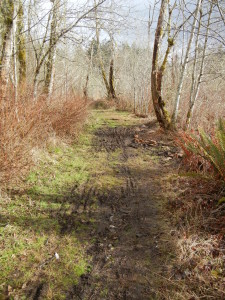 As any good hiker should, I checked a few website reviews of the Millersylvania trails before heading out there myself. Several user-submitted posts at the Washington Trails Association website pointed out that the trails in this state park were not well-kept and many were fraught with mud holes, downed trees or other maladies. Within minutes of leaving the boardwalk part of the entry trail, I could see that the reviews were indeed accurate about the mud holes. There were dozens of them sprinkled along the path, some with dog paw prints and others with mountain bike tire tracks. Since I had my waterproof Hi-Tec Sierra Lite I WP hiking boots on I didn’t give these muddy obstacles a second thought, although one particular snare swallowed my boot whole nearly up to the cuff itself. That gave me a bit of pause, but at no point did my feet ever get wet. Or even cold. Dang, I love those boots.
As any good hiker should, I checked a few website reviews of the Millersylvania trails before heading out there myself. Several user-submitted posts at the Washington Trails Association website pointed out that the trails in this state park were not well-kept and many were fraught with mud holes, downed trees or other maladies. Within minutes of leaving the boardwalk part of the entry trail, I could see that the reviews were indeed accurate about the mud holes. There were dozens of them sprinkled along the path, some with dog paw prints and others with mountain bike tire tracks. Since I had my waterproof Hi-Tec Sierra Lite I WP hiking boots on I didn’t give these muddy obstacles a second thought, although one particular snare swallowed my boot whole nearly up to the cuff itself. That gave me a bit of pause, but at no point did my feet ever get wet. Or even cold. Dang, I love those boots.
Along the lake shore were several Canada geese taking advantage of the nutritious algae that grows along the shore (see picture above). I wanted to get close enough to get some good pictures of them, so I began hopping from tree to tree in an attempt to “stalk” them, but unfortunately – despite my camouflage clothing and slow, methodical movement – wild animals (even geese) are naturally endowed with heightened senses that alert them to just such a thing. They saw me coming, and headed out into the water before I could get a good, close-up photo. As a matter of fact, they then swam along the lake shore, following me as I proceeded down the trail, honking to alert others to my presence. So much for stealth.
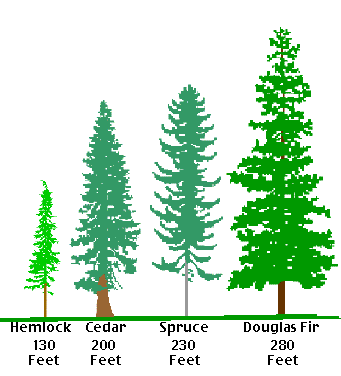 After the trail curved north away from the lake, it ascended into a beautiful old growth forest with trees as wide as I am tall. One particular set of trees caught my attention because I thought there was probably a nice, sad story behind them. Twin Douglas Firs (or Western Hemlocks, I’m not sure which), now about six feet in diameter, had begun life at the same time. They grew up together, weathered storms together, hosted an endless stream of avian families. Until one day, something happened to one of them. It’s unclear from the remaining stump if one of them was cut down or felled by a fire, lightning, wind, or other natural cause. But it’s clear that only one remains, along with the speculation about what may have happened all those years ago.
After the trail curved north away from the lake, it ascended into a beautiful old growth forest with trees as wide as I am tall. One particular set of trees caught my attention because I thought there was probably a nice, sad story behind them. Twin Douglas Firs (or Western Hemlocks, I’m not sure which), now about six feet in diameter, had begun life at the same time. They grew up together, weathered storms together, hosted an endless stream of avian families. Until one day, something happened to one of them. It’s unclear from the remaining stump if one of them was cut down or felled by a fire, lightning, wind, or other natural cause. But it’s clear that only one remains, along with the speculation about what may have happened all those years ago.
Continuing along the trail system, I encountered what had to have been the largest Douglas Fir in the forest. At least 10 feet in diameter, this behemoth had bark veins at least six inches deep. Though pictures never can accurately convey just how big these monster trees really are, I had to get some shots of it anyway. I have some cool software that allows you to merge three photos of the same thing in order to bring out highlights that aren’t readily apparent and I used it to get a nice, dramatic shot of the monster Fir. The accentuated moss on the trees in the background looks cool too.
One of the things that interested me about the Millersylvania trail system was the fact that there is a good deal of history in the park. On its website, the park is described as having relics of a narrow-gauge railroad, and several skid roads used in the 1800’s by the logging industry, and stumps of trees still carry notch scars where springboards supported brawny loggers. I was fortunate enough to spot one of these notched stumps just off the trail and stopped to imagine the effort made to get it down over a hundred years ago. For Washington State history buffs like me, this was a great place to take a few moments and daydream.
Soon I realized that I had been hiking for nearly two hours and my wife would soon be calling. As I continued north, making a park-wide loop out of the trails, I stumbled into a clearing where I suddenly heard a very distinctive sound. Looking up, I spotted a pair of bald eagles about 300 yards away notifying everyone in the forest of my presence. I was able to get my camera into video mode and record a few seconds of their calls before one of them flew away.
Just before I popped back out into the parking lot, the sun broke through and illuminated the wet forest beautifully. Batteries recharged, I took one more picture and rejoined the family as we headed home.
- As close as I could get.
- Nice shot of the swimming area.
- Mud on the trails.
- Tonemapped image of the trail’s ascension.
- The lost twin.
- Tonemapped image of the monster doug fir.
- Century-old springboard notches.
- Majestic bald eagles.
- Tonemapped image of a bridge crossing a creek.
- Sun setting through the wet trees.
- Batteries recharged.


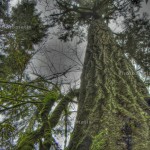
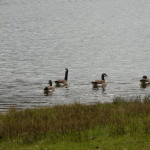
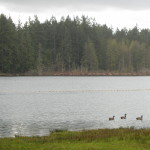
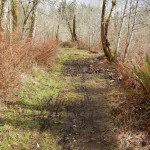
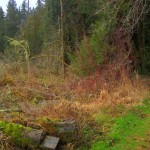
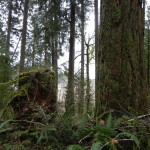
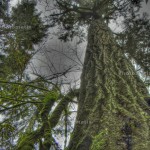
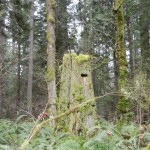
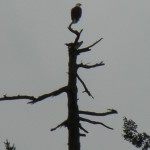
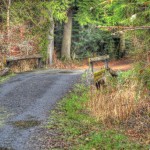
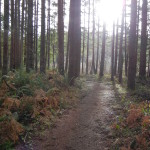
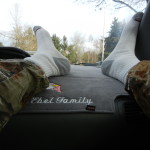
Thanks for reading! This summer I hope to do a video feature on Washington, Our Home, that begins in Oregon’s Willamette Valley and treks north into Washington. Hopefully the eagles will be calling then!
Nice blog post. It’s so nice to get out and about, and enjoy a good hike in the winter. We are getting more and more bald eagles here in the south Willamette Valley of Oregon. I don’t think I’ll ever tire of hearing their call.